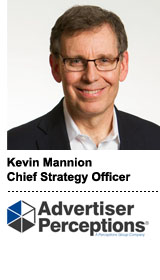 Google’s Display and Video 360 demand-side platform is in a tough fight as offerings from Amazon and The Trade Desk equal or exceed Google’s usage rates, according to Advertiser Perceptions’ quarterly tracking report.
Google’s Display and Video 360 demand-side platform is in a tough fight as offerings from Amazon and The Trade Desk equal or exceed Google’s usage rates, according to Advertiser Perceptions’ quarterly tracking report.
The report surveys 314 media executives, split between brands and agencies, about their opinions of the major buying platforms. The report tracks mind share of ad tech companies among the ad buying community.
Google, Amazon and The Trade Desk have consistently separated from DSP competitors in recent years, but Google’s DV360 is being surpassed by the Amazon DSP and The Trade Desk, in terms of use.
Amazon’s DSP first surpassed Google’s DV360 (née DoubleClick Bid Manager) in 2017 as the most-used DSP. Since then Amazon’s DSP has grown from 40% of all digital ad buyers to 46%, while Google’s use has dropped from 36% to 33%.
Now, Google faces stiffening competition from The Trade Desk, such that Amazon is the most used DSP, followed by The Trade Desk, with Google settling into third.
And, unlike Google, Amazon and The Trade Desk are growing into new parts of the programmatic buyer market. Amazon has historically been a managed service, while The Trade Desk set its roots in self-serve tech. Each still leads in its own native category, but both are now also active in self-service and managed service, said Kevin Mannion, Advertiser Perceptions’ chief strategy officer.
“More and more we see Google is in tough fights on two sides,” Mannion said of the managed and self-serve DSP businesses.
One issue with a tracking report that measures sentiment and subjective questions is that eagerness to try and support alternatives could understate actual market share. DV360 still leads in criteria such as audience scale and client platform integration among the survey respondents.Tier two
There is a clear drop-off after the big three DSPs, but that isn’t necessarily bad for the second tier players.
MediaMath’s growth, for instance, has been volatile in recent years, but in 2019, its usage and consideration for the next year grew steadily, Mannion said.
MediaMath and the Adobe Advertising Cloud, which slipped for a year or so following its acquisition of the TubeMogul DSP as it digested the tech and went to market, have steadily gained adoption in the past couple years despite the big three, Mannion said.
These second tier offerings are aided by recent consolidation. This was the first wave without Sizmek, which is now part of the Amazon Advertising Platform – bumping others up a spot in the rankings, regardless of performance.
Some long-time DSP category leaders have faded. Verizon Media has packaged AOL, Yahoo and other former standalone DSPs like Brightroll, thus removing many DSP vendors from the market without creating another must-have platform.
Advertiser Perceptions had Verizon Media tied with The Trade Desk as the third most-used DSP a year ago, and before that AOL and Yahoo were Google’s main contenders. Now Verizon has dropped to seventh, among competitors like Amobee, Tremor Video and Criteo. It has fallen behind AppNexus, MediaMath and Adobe, which have gained despite headwinds for independent DSPs, Mannion said. Though the Verizon DSP was mislabeled as Oath, the ad tech unit’s former name, during the time of the survey.
The independent market is also being helped by a rise in the total number of DSPs used by brands and agencies. The average number of DSPs dropped from five to six a few years ago to three by 2018, but has ticked back up to four.
“Unlike the DMP market where we’re seeing actual shrinkage, there is an expansion of the number of DSPs being used or tested,” Mannion said.
The DSP consideration metrics from a year ago line up well with how the market has shaken out in subsequent reports, he said. “There are three DSP leaders. After that the DSP category is a real horse race for five companies.”














